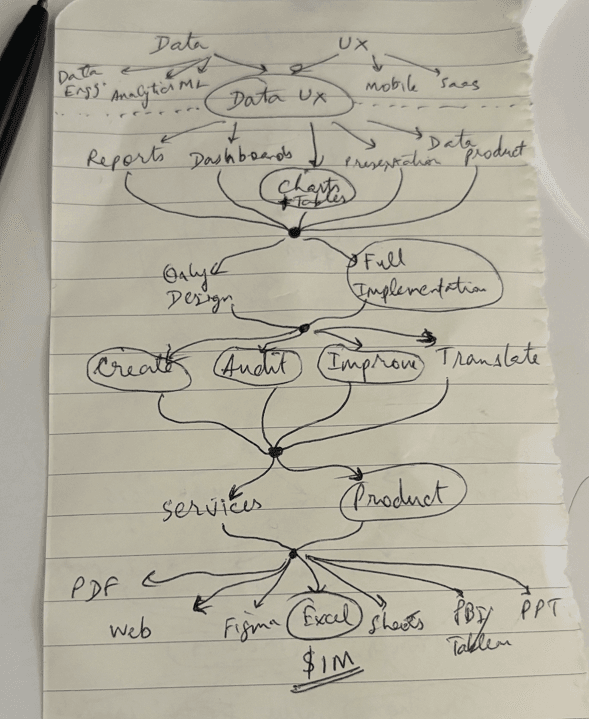Pre-2024 startup pundits:
"Everyone has an idea. Execution is where you win".
Post-2024 pundits:
"Everyone can execute. The quality of your idea is where you win"
Me:
"Ideas and execution are both bloody hard to do well, but AI makes it easier to do so".
A hodgepodge of thoughts about ... ideas
- What exactly is an idea? Is it a problem or a solution or a market opportunity or a technology shift or something else? Or is it a combination of all of these?
- Where do ideas come from? From observing the world, or a personal pain point, or a top-down analysis of the market, or somewhere else?
- How do you flesh out an idea? Customer segments, competitors, alternatives, market size/trajectory, trends, head winds, tail winds, technology shifts, strategic angle, bigger picture, positioning.
- What differentiates a bad idea from a good idea? Is there an objective way to score ideas based on your goals / constraints
- How do you refine or enrich an idea? Is there a way to reason through what adjacent / analogous idea would score higher?
- How do we evaluate the impact of an idea? What change would happen in the world if this idea were successful?
- When is an idea good enough to act on? What are the criteria that signal that we can proceed with validation? Can we be objective about it? How do we incorporate our goals and constraints into this score?
Turning "idea clutter" into clarity
1. The seed of an idea
- It can come from anywhere (personal pain point, observing the world, news, "wouldn't it be cool if ...", etc)
- It can be anything (problem, solution, tech capability, market opportunity, etc)
- It can be good or bad, from the point of view of your goals
2. Fleshing out the idea
That seed of an idea still needs to be fleshed out. There's a lot of relevant context locked away in the entrepreneur's head, which has to be extracted so that you can figure out "What exactly does this idea mean?"
- Personal experiences and observations that might have led to this idea
- Thoughts around who will benefit, what are their pains, how do they solve it currently, etc
- Potential avatars that the solution might take. Eg. mobile app, AI agent, API, etc
- Competitors that you might have been tracking
- How you view / split the market. Eg companies that make charts for client deliverables vs companies that make charts for internal reporting.
Another important concept that helps me is the "idea tree". It gives context about where exactly an idea "sits" in the market. Very often, we get too micro with our ideas without really understanding where they sit in the hierarchy. Too broad, and you will be playing a different game and fighting a different league of competition. Too small, and you will find yourself in a niche that has very little demand where it's hard to find / locate your customers. Here's an example of the idea tree for ChartBoss - it makes me realise that my product is quite far down this idea tree: Data + UX -> Data UX -> Charts -> Product -> Excel.

3. Getting to a "complete idea"
It takes some hard thinking to make an idea complete - you can either use an existing framework like "Lean Canvas" or make your own.
In the Lean Canvas for example, the dimensions you would consider are Customer, Problem (functional + social + emotional jobs-to-be-done), Solution, Alternatives, Unique Value Proposition, Unfair Advantage, Channels, Key Metrics, Revenue Streams and Cost Structure. You could also include additional elements like Market Size / Trends, Timing, Size of Outcome, Unit economics, competitive landscape, etc.
Some of these dimensions above are informed by our own hypotheses and context, some of them come from conversations with people connected to the problem, and some of them can be completed using the help of AI.
4. Generating "idea variants"
The key is to generate variants of the idea while still keeping it's essence intact. AI excels at this, so this is where we should be bringing in massive parallellization.
- What if there's another customer segment that experiences this pain even more acutely?
- What if there's an adjacent market where this solution would work even better?
- What if this tech has a better use case in a different problem?
- If we deliver the solution in a different form factor, will it unlock a bigger market?
- Is there a broader / more holistic use case that makes more sense?
5. Evaluate / score the idea
Just like we needed a framework to evaluate if the idea is complete, we also need a framework to evaluate if the idea is good. And "good" means different things to different people, so calling any idea "good" is entirely contextual.
If we can first understand our own goals, then we can understand how this idea helps us achieve those goals. And that let's us assign a score to the idea.
If the goal is to "build a portfolio of bootstrapped, profitable, AI-first, micro-saas B2B products", then you will find a very different type of idea rising to the top, versus if the goal was to "build a venture-scale vertically-integrated b2c company in the organic food segment".
So, finalise some dimensions along which to score each idea, and an objective way to assign a score for each dimension. Now, we can score the idea along with its variants, to see if any of them make the cut.
6. What comes next? Validation!
Ideas that score above our cutoff value make it to the next stage - validation. And not just validation, but systematic validation. Which we'll explore in our next blog.
See you there!